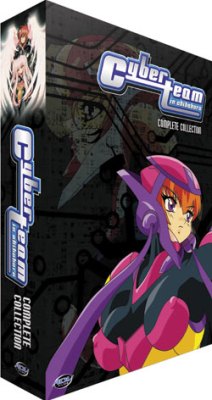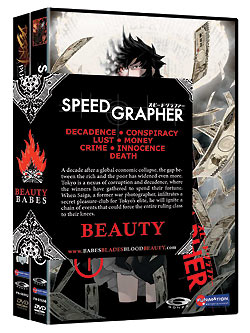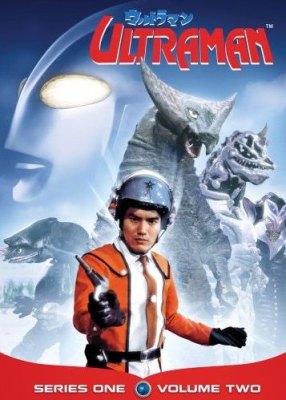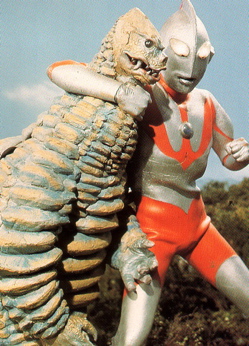AnimeTalk
a bi-weekly column by Don Houston, John Sinnott, and Todd
Douglass
This week Anime Talk looks a several interesting series. Paniponi
Dash: Lethal Lesson has an 11-year-old genius teaching a class
of hyper high school girls. It's a weird but entertaining show full of
pop culture references that will be sure to please fans of Excel Saga.
Gaogaigar is a giant robot series that is a lot of
fun, and the hilarious Ninja Nonsense
has come to an end. There are capsule reviews of the lasted series
sets including Gad Guard, the Mermaid Forest, Star Ocean
Ex, and more. We also have a special treat this week. DVD Talk
reviewer Stuart Galbraith IV is known as an authority on director Akira
Kurosawa and actor Toshiro Mifune (his book on the pair, The Emperor and
the Wolf, has been praise by Martin Scorsese as "a must read."), but many
people don't realize that he's also a fan of Kaiju films. Stuart
provides a look at the second volume of Ultraman
episodes for us this time, and includes a lot of background information
on the series and the legal problems that it has had. Of course Holly's
back with her anime bargains, just
in time for the holiday buying season, and we have our list of up
coming discs so you'll know what to ask Santa for. If you're
having trouble finding that prefect gift for an anime check out our Top
Ten Anime discs of 2005 article.
The
Latest Anime Reviews:
(Click on the links to read the full review.)
One of the weirdest yet most entertaining releases of the year got an
early look this week as Paniponi
Dash: Lethal Lesson proved to be full of enough pop culture references
to keep us replaying all five episodes in order to determine each of them.
The promise of fan superstardom in the form of a contest was the icing
on the cake as 11 year old genius teacher Rebecca Miyamoto faces her greatest
fear; a classroom full of spastic high school girls that drive her (and
everyone else within earshot) crazy. If you liked the Excel
Saga series as much as we did, you'll love the inclusion of AD Vidnotes
used to clue you in on various aspects of the scenes thanks to the folks
at ADV Films.
We close out the popular Tetsujin
28: Advance and Tetsujin
28: Conspiracy, this week. Shotaro has to face the possibility that
his metallic friend is more than just a tool to be used for good as the
forces of evil all seem willing to bet everything they have on a high stakes
gamble involving the power of the mysterious bagume, Tetsujin, and an entire
robotic army that proves difficult to control.
Baki the
Grappler is still trucking along with its awkward pacing even in volume
10. The series started out very strong with an interesting premise but
as the show got older it began to grow long in tooth. The fighting tournament
that Baki finds himself in has become bereft of the titular character and
in the past few volumes we've had to sit through episode after episode
of second tier characters beating the snot out of each other. Baki's plight
with his father has essentially become meaningless as he only appears a
few times in each volume. The tenth volume has some interesting moments
but the best thing about it is the fact that the tournament is almost over.
Star Ocean
Ex: Complete Box Set was another series designed for the younger crowd
with a boy named Claude leading an expedition on a foreign world after
he gets swept away by advanced technology far beyond the immediate reach
of his commander father. The series was admittedly a bit light as it was
derived from an older RPG videogame but it had some interesting quirks
that some of you are likely to enjoy as the quest theme is catered to at
length.
Gad Guard:
Complete Boxed Set seemed like the kind of anime a lot of younger fans
will enjoy this Christmas season. The show is a futuristic story about
a 16 year old boy named Hajiki Sanada who comes across a mysterious device
called a Gad that everyone wants and are willing to do anything to get
ahold of. The Gad essentially grants people a wish and morphs into a Techode;
a large robot that fights for Hajiki as he seeks to understand why he was
chosen by the device. Seeing all 26 episodes at once was a bit more than
we were prepared for but it was still a series that younger audiences might
enjoy a fair amount.
For the better part of anime's existence one of the most prominent themes
has been ninjas fighting demons. While the characters in Basilisk
may not be "demons" in a direct translation of the word they do possess
supernatural ninja abilities and are fighting with one another. A clan
war has erupted between the Iga and the Kouga and every episode brings
each faction closer to extinction. In the third volume we finally get to
see what Gennosuke's powers really are and let's just say it's easy to
see why he leads his clan. There is quite a bit of character development
this time around and that really helps the volume recover from the fact
that there is a recap episode wedged in the middle.
I don't know about you, but we can't get enough of giant robots fighting
monsters. In fact we'd say that most otaku find themselves attracted to
the genre because there are so many shows featuring just that. Gaogaigar
is a series that came out in the 90's and is essentially a tribute to those
that came before it. The show focuses on a couple of characters, though
it starts out by paying attention to a young boy who was delivered to a
human couple via the mouth of a mechanical lion. Since then the mechanical
lion has garnered a cyborg counterpart and together they all fit into some
grand design to defend the world against an alien threat. It's not the
most original concept in the world but it is certainly inspired with a
fair amount of intrigue and great presentation. Fans of the genre should
definitely pay attention to this one if they haven't already.
Begrudgingly we have come to accept that Ninja
Nonsense has released its last volume. This small series instantly
proved itself to be endearing and hilarious all at the same time. Taking
place between the real world and a ninja village the story follows the
misadventures of Shinobu, Kaede, and some whacked out ninjas. Each of the
four volumes basically represent a season with the final being winter,
of course. Kaede teaches the ninja about Christmas and together they celebrate
New Years. The ending fits the show very well and throughout this anime
has been irreverently entertaining. Check it out if you want a laugh.
In the third volume of Kamichu!,
Japan's youngest god encounters some more problems that only a god could
have. First she has to move a battleship, and then attend Godcon,
a convention for deities, while studying for midterms. That's not
to mention getting wrangled into running for student council president.
An inventive and cute program, this show is just a lot of fun. It's the
type of show that Hayao Miyazaki would make if he ever produced for the
small screen; charming and wonderfully engaging. This is the perfect
show to screen for someone who claims to hate anime.
Ahhh, series sets. Don't ya love 'em? There's nothing
better than getting the entire run of a show in one fell swoop. No
more waiting months to see how a cliff-hanger worked out or how an interesting
plot line was resolved. Often times the show is more enjoyable that
way too. Sometimes it's hard to plunk down another $20 or more for
a four episode volume of a show that's only so-so, but if you don't you'll
never know if it gets better. One series that falls into that category
is Daphne in
the Brilliant Blue. If I was buying these episodes one volume
at a time, I don't know if I would have finished the show. There
were a few too many filler shows and stories that didn't seem to have any
point. If you keep with it however, there is a very good story buried
among what appears at first glance to be a typical girls-with-guns show.
Though there may be a few anime fans that don't recognize Rumiko Takahashi's
name, I doubt that there are many who aren't familiar with her work.
Known as the "Princess of Manga" she's the woman behind such manga (and
anime) series as Urusei Yatsura (also known as Lum), Maison
Ikkoku, and fan favorite Ranma ½. She's created
many popular series over her 25+ year career, and is known for her humorous
stories that have a lot of heart. But Takahashi is a very talented
artist, and she's not limited to one story type as is shown with Mermaid
Forest. Darker and less light-hearted than her other series,
this story of immortals and monsters will surprise many of her fans.
It's very unlike her other works, but that doesn't mean it isn't good.
(For another look at this series, check out Don Houston's reviews of the
individual volumes here: One,
two,
three,
four.)
Be sure to take a look at recommendations by DVDTalk's twisted cast
of reviewers in their Best
Of Anime 2003, Best
Of Anime 2004, and Top
Ten Anime discs of 2005 articles.
Upcoming
Releases
Holly's
Anime Bargains
Presented
by Holly Beeman
Amazon Slick Catch:
Neon
Genesis Evangelion: Platinum Collection: $45.96, [review]
retail
price: $89.98 - 49% off!
 Check
Out Your Local Best Buy for:
Check
Out Your Local Best Buy for:
All Purpose Cultural Cat Girl Nuku Nuku: TV Collection: $12.99, [review]
retail
price: $44.98 - 71% off!
Aquarian Age: Complete Collection: $10.99, [review]
retail
price: $39.98 - 72% off!
Blue Seed: Complete Collection: $22.99,
retail
price: $59.98 - nearly 62% off!
Chrono Crusade: Complete Collection: $34.99, [review]
retail
price: $89.98 - 61% off!
Cyberteam
in Akihabara: Complete Collection: $20.99, [review]
retail
price: $49.98 - 58% off!
Eden's
Bowy: Complete Collection: $16.99, [review]
retail
price: $39.98 - 57% off!
Gravion: Complete Collection: $10.99, [review]
retail
price: $39.98 - 72% off!
Gravion
Zwei: Complete Collection: $19.99, [review]
retail
price: $39.98 - 50% off!
Happy
Lesson: Teacher's Pet Collection: $16.99, [review]
retail
price: $39.98 - 57% off!
Kaleido Star: Amazing Collection: $14.99, [review]
retail
price: $49.98 - 70% off!
Legend
of the Mystical Ninja: Complete Collection: $20.99,
retail
price: $49.98 - 58% off!
Mezzo: Complete Collection: $15.99, [review]
retail
price: $39.98 - 60% off!
Original Dirty Pair: Movie Collection: $6.99, [review]
retail
price: $24.98 - 72% off!
Original Dirty Pair: OVA Collection: $6.99, [review]
retail
price: $24.98 - 72% off!
Petite
Princess Yucie: Complete Collection: $24.99,
retail
price: $59.98 - 58% off!
Pretear:
Complete Collection: $22.99, [review] retail
price:
$39.98 - nearly 42% off!
Saint Seiya: Collection 1: $14.99 , [review]
retail
price: $49.98 - 70% off!
Saint
Seiya: Collection 2: $20.99,
retail
price: $49.98 - 58% off!
Super GALS!: The Iron Clad Collection: $14.99, [review]
retail
price: $49.98 - 70% off!
Wedding Peach: Season 1: $10.99, [review]
retail
price: $39.98 - 72% off!
Wedding
Peach: Season 2: $16.99,
retail
price: $39.98 - 40% off!
Wild Arms: Complete Collection: $10.99, [review]
retail
price: $39.98 - 72% off!
Best Prices Awesome Grab:
Gantz:
Season 1: $43.22, [review]
retail
price: $69.98 - 38% off!
Buy Mecha Deal:
Giant
Robo: Complete Economy Set: $18.60,
retail
price: $24.95 - nearly 26% off!
 Scorching
Hot Deals from Deep Discount DVD:
Scorching
Hot Deals from Deep Discount DVD:
All
Purpose Cultural Cat Girl Nuku Nuku: Dash! Complete Collection: $26.99, [review]
retail
price: $44.95 - 40% off!
Astro
Boy: Collection Box Set: $19.96, [review]
retail
price: $39.95 - 50% off!
Blue
Gender: Complete Collection: $36.29,
retail
price: $59.95 - you save $23.66!
Descendants
of Darkness: DVD Collection: $21.58, retail
price: $49.95 - you save $18.37!
DNA²:
DVD Collection: $26.98, retail price:
$49.95
- 46% off!
DNAngel:
Complete Collection: $53.99, [review]
retail
price: $88.95 - 40% off!
Jing:
King Of Bandits Collection: $23.99, [review]
retail
price: $39.95 - 40% off!
Kino's
Journey: Complete Collection: $23.99, [review]
retail
price: $39.95 - 40% off!
Najica
Blitz Tactics: Complete Collection: $23.99, [review]
retail
price: $39.95 - 40% off!
Orphen
II: Revenge Collection: $23.99, [review]
retail
price: $39.95 - 40% off!
Real
Bout High School: Complete Collection: $24.00, [review]
retail
price: $40.00 - 40% off!
Revolutionary
Girl Utena: The Rose Collection: $21.58,
retail
price: $39.95 - you save $18.37!
Revolutionary
Girl Utena: The Black Rose Saga Collection: $21.58,
retail
price: $39.95 - you save $18.37!
Rune
Soldier: Complete Collection: $23.97, [review]
retail
price: $39.95 - 40% off!
Sakura
Wars TV: Complete Collectionn: $29.99, [review]
retail
price: $49.95 - 40% off!
Those
Who Hunt Elves: Complete Collection: $29.99, [review]
retail
price: $49.95 - 40% off!
DVD Empire Raid:
Gokusen:
Complete Economy Set: $12.61,
retail
price: $19.95 - 37% off!
 Orbiting Deals from DVD Planet:
Orbiting Deals from DVD Planet:
Neo Ranga:
Complete Collection: $36.95, [review]
retail
price: $59.95 - you save $23.00!
Noir:
Complete Collection: $55.95, [review]
retail
price: $89.95 - you save $34.00!
RahXephon:
Complete Collection: $57.95, [review]
retail
price: $89.95 - you save $32.00!
 Sweet Steals from Overstock:
Sweet Steals from Overstock:
Angelic
Layer: Complete Collection: $29.64, [review]
retail
price: $49.98 - 40% off!
Azumanga
Daioh: Class Album: $41.14, [review]
retail
price: $69.98 - 41% off!
Chobits:
Complete Collection: $64.13,
retail
price: $99.98 - 35% off!
Final
Fantasy Unlimited: Complete Collection: $29.64, [review]
retail
price: $49.98 - 40% off!
Full
Metal Panic!: Complete Collection: $52.64, [review]
retail
price: $89.98 - 41% off!
Gantz:
Season 2: $41.14, [review]
retail
price: $69.98 - 41% off!
Last
Exile: The Murata Range Complete Set: $64.13, [review]
retail
price: $99.98 - 35% off!
Magical
Shopping Arcade Abenobashi: Complete Collection: $29.64, [review]
retail
price: $49.98 - 40% off!
Peacemaker:
Complete Collection: $52.64, [review]
retail
price: $89.98 - 41% off!
Revolutionary
Girl Utena: The Apocalypse Saga Collection: $24.81,
retail
price: $39.95 - 37% off!
Samurai
X: Director's Cut Collection: $26.76, [review]
retail
price: $44.98 - 40% off!
Sister
Princess: Complete Collection: $29.64, [review]
retail
price: $49.98 - 40% off!
Steam
Detectives: Complete Collection: $29.64, [review]
retail
price: $49.98 - 40% off!
Zone
Of The Enders: Complete Collection: $29.64, [review]
retail
price: $49.98 - 40% off!
 Right
Stuf New Weekly Specials:
Right
Stuf New Weekly Specials:
Ai
Yori Aoshi DVD/CD Combo Box Pack: $9.99, retail
price: $44.98 - nearly 78% off!
Aquarian
Age: The Movie DVD (Hyb) (Limited Edition): $21.99, retail
price: $59.98 - nearly 64% off!
Cardcaptor
Sakura DVD Mega Bundle (DVD 1-18) (S): $79.99, retail
price: $539.82 - 85% off!
Gonzo
Double Pack: Basilisk 1/Trinity Blood 1 DVD (Hyb): $19.99,
[review 1, review 2]
retail
price: $49.98 - 60% off!
Gonzo
Double Pack: Desert Punk 1/Speed Grapher 1 DVD (Hyb): $19.99,
[review 1, review 2]
retail
price: $49.98 - 60% off!
Licensed
by Royalty (L/R) DVD Bundle (1-4) + Audio CD Prepack: $34.99,
[review]
retail
price: $134.90 - 74% off!
Read
or Die (R.O.D.) TV Series DVD MegaBundle (Hyb) w/CDs: $79.99,
[review]
retail
price: $239.82 - 67% off!
Saber
Marionette J - Ultimate Collection DVD Set (Limited
Edition):
$69.99, [review]
retail
price: $199.98 - 65% off!
Tenchi
Muyo: Tenchi in Tokyo DVD Bundle Pack (1-8) (Hyb): $59.99,
retail
price: $159.99 - you save $100!
For more anime deals check out the
Official
- ANIME Bargains! - Thread. Updated daily by yours truly!
Featured
review:
Ultraman
Series
One, Volume Two
by Stuart Galbraith IV

Excitement that Ultraman (1966-67) - the seminal Japanese
superhero/tokusatsu ("visual effects") TV show of the 1960s - was
coming to DVD was severely tempered by problematic, hugely disappointing
transfers. Volume Two of this collection, featuring the remaining
19 shows, addresses some of the problems and though the collection is still
far from perfect, these issues are less the major distraction that they
were before.

A follow-up of sorts to the
Outer Limits/
X-Files-like
Ultra
Q (1965),
Ultraman (
Urutoraman: Kuso tokusatsu shirizu,
or "Ultraman - A Special Effects Fantasy Series") follows the adventures
of the Science Patrol, an elite quasi-police force/scientific investigation
team whose futuristic gadgets rival Britain's International Rescue (on
Thunderbirds). Led by stalwart Captain Toshio "Cap" Muramatsu (Akiji
Kobayashi), the Science Patrol consists of brave marksman Daisuke Arashi
(Sandayu Dokumamushi), inventor Mitsuhiro Ito/Ide (Masanari Nihei), a very
Japanese-style comic relief straight out of a Japanese
manga, and
the cute lone female member of the team, communications officer Akiko Fuji
(Hiroko Sakurai). Finally there's gregarious deputy Shin Hayata (Susumu
Kurobe) who, unbeknownst to the Science Patrol, can transform himself into
the giant superhero from Nebula M7B: Ultraman (Bin Furuya).
The series is a delight, setting the template for myriad Japanese fantasy
shows that followed in its wake, its influence extending to theatrical
features as well. (The sensibility of Japan's kaiju eiga of the
late-1960s, especially films like Destroy All Monsters and The
X from Outer Space, were enormously influenced by Ultraman rather
than the other way around.) While Eiji Tsuburaya's artisans strived for
an illusion of reality with their intricate miniatures and elaborate optical
effects, story- and character-wise, including the monsters and Ultraman
himself, realism simply was not a concern.
Indeed, the show was among the first to embrace a kind of alternate
20th century fantasy universe, where present-day life freely interacts
with fantastic new technology (the Science Patrol's iconic Jet VTOL/Beetle
and laser-guns, for instance), where giant monsters are a part of everyday
life, and where bizarre creatures like the benign Pigmon (a blobish, child-sized
red carnation of a monster with doll-like eyes and droopy, hamster-like
paws) can turn up in a department store's toy department - where Ultraman
toys are sold, natch - and be regarded more of a nuisance than a threat.
This casual attitude is a big part of the show's appeal, and the earnestness
of the cast sells the often outrageous storylines.
Volume Two is more of the same, with episodes in turn typically
zeroing in on one member of the Science Patrol, and with many of these
later shows referencing earlier stories and monsters, some of whom make
return appearances. Though not a Toho series, many of that studio's contract
players would turn up here in guest-starring roles, including Yutaka Sada
(the chauffeur from High and Low), Senkichi Omura (King Kong
vs. Godzilla), Ren Yamamoto (Gojira), Hisaya Ito (the inept
assassin in Ghidrah), and Akihiko Hirata (Samurai II, Sanjuro,
and countless kaiju eiga).
Beyond the highly imaginative if TV-budget level special effects, other
aspects of the show easily ignored are top-notch. Frequent series director
Akio Jissoji helmed several highly stylized, almost surreal episodes, while
scripts by Tetsuo Kinjo especially show a lot of imagination. Finally,
Kunio Miyauchi's score, notably its title and Science Patrol themes, is
quite charming and, once heard, hard to get out of your head.

Ultra Lawsuit
Although BCI/Golden Media Group's Ultraman - Series One feature
English subtitled versions of essentially uncut episodes, the alternate
English-dubbed audio tracks are incomplete, and missing English audio meant
that characters would be speaking English one minute, then dialogue would
abruptly slip into Nihongo and back again. The booklet included
with Volume Two states that "before Ultraman aired on television
in the U.S., the show was cut to fill a specific time slot and the English
audio dubbing was created for this newly edited version." In fact the reverse
was true: the show was edited-down by local channels long after
the English dubbing was completed. After original U.S. distributor United
Artists Television's rights expired, the complete English-dubbed audio
masters were returned to Tsuburaya Productions.
Worse, the video and audio transfers for both volumes are substandard;
on Volume One especially, the video is downright headache-inducing.
Though fairly sharp, all movement is severely pixilated: characters would
walk across the room with robot-like jerkiness, while the monster battles
jittered like crude stop-motion animation, so distracting was this transferring
snafu. (You can read John Sinnott's review of Volume 1 here.)
BCI took a lot of well-deserved heat for these poor transfers, though
they were only partly to blame. The problem is rooted in a nasty, decade-long
legal battle over distribution rights between Tsuburaya Productions, the
Japanese production company that produced Ultraman, and a Thai firm
called Chaiyo Productions.
Back in the mid-1970s, when the two companies were on friendlier terms
and had teamed up for several co-productions, Chaiyo founder Sompote Saengduenchai
claims Tsuburaya Productions president Noboru Tsuburaya (son of SPFX pioneer
Eiji) sold him virtually all worldwide rights (outside Japan) to Ultraman
and its spin-offs (Ultra Seven, etc.) produced up to that point
in exchange for a monetary loan. Tsuburaya Productions, on the other hand,
claim the contract Saengduenchai suddenly produced in the 1990s was nothing
more than a blatant forgery. Nevertheless, both Japanese and Thai courts
ruled in favor of Chaiyo.
The case seems to have hinged largely on the fact that the alleged contract
bears Tsuburaya's official company stamp. Tsuburaya's position apparently
is that the document itself is a forgery while they begrudgingly acknowledge
that the company seal on it might be genuine. Though business hanko,
as such stamps are called, are normally kept under lock and key, Tsuburaya
reportedly gave Saengduenchai free reign at the company's Setagaya studio
and some have suggested the Thai producer nicked the hanko when
his Japanese partners weren't looking. Others argue that the seal is also
a forgery.
Though BCI has stated publicly that they would have preferred to have
dealt with Tsuburaya Productions directly, in the eyes of the Japanese
and Thai courts home video rights to Ultraman clearly rested with
Chaiyo Productions, and so it was through them that the show was licensed.
However, all the original film and audio elements and digital masters are
still owned by and reside with Tsuburaya Productions. Tsuburaya claims
BCI and/or Chaiyo has to date never contacted them about accessing masters,
while BCI has at least suggested they were denied access to Tsuburaya's
elements.
This case is extremely unusual. Tsuburaya is currently appealing the
ruling against them in the Japanese courts (a case is likewise pending
in China), which would justify their refusal to release original elements
or clones to Chaiyo for now. However, if the ruling is upheld and their
legal options become exhausted, it would be unreasonable on Tsuburaya's
part not to provide Chaiyo and/or their licensees access even if all
of Tsuburaya's claims are true. When rights are split between multiple
distributors it's common practice for the holder of the film elements to
provide these other firms access or, more commonly, clones of their masters
at cost with perhaps a nominal access fee.
Video & Audio
Because of this ongoing problem, Chaiyo had to come up with masters
on its own, and those they provided BCI with were inexcusably poor. Because
Chaiyo's own elements were limited to battered 16mm prints, they essentially
swiped the video and audio directly from store-bought Region 2 Japan DVDs
distributed by Panasonic, and the pixilation problem apparently is related
to the process of creating new masters from these commercial DVDs.
For their part BCI should have flatly refused to accept them. Contractually
Chaiyo would have been responsible for delivering acceptable masters and
clearly these weren't. Needless to say, Chaiyo didn't exactly ask Panasonic
if it was okay that they use their masters, while BCI's trumpeting this
"re-mastered version" with its "stereo sound and brilliant color" is rather
distasteful considering they neither paid for this work nor had anything
to do with it anymore than Chaiyo did.
The good news is that while some of these issues persist in Ultraman
- Series One, Volume Two, the pixilation problem has been greatly reduced
while the transfers have improved in other areas. Now, for instance, the
English version of the theme song is heard over the opening credits on
the English track (twice actually, to match the running time of the Japanese
credits): on Volume One, the Japanese version of the theme song, unsubtitled,
played over the credits. However, there's still English audio missing from
episodes, emphasized by the fact that the mono English audio, probably
culled from bootlegged VHS tapes, is frequently very poor while the Japanese
soundtrack is crystal clear and remixed for Dolby Stereo. (It would have
been less jarring if everything had been mixed mono.) Episodes still abruptly
end without credits or promos for the next episode.
Fortunately, the Japanese audio with the newly-created English subtitles,
combined with the reduced pixilation, make Ultraman Series One, Volume
Two a lot more palatable. The three, single-sided DVDs have seven,
six, and six episodes per disc, respectively, and offer decent bit-rates.
Extra Features
It's really a great shame this and other "Ultra" series are mired in
such a legal quagmire with resentment all around. BCI's packaging is quite
nice. Volume Two comes with another useful eight-page, full color booklet
featuring a good episode guide and essay by Denny Azumabashi and Montey
Yamazaki. Kids will like the two collectible cards featuring Ultraman's
foes and a Kaiju Encyclopedia offering details on the show's
various monsters.
Parting Thoughts
Ultraman is a series fans have wanted to see again, especially
in its original form, literally for decades. It's unfortunate then that
forces beyond the control of its American distributors, indeed beyond all
the might and technology of the Science Patrol, have so severely compromised
these releases. For the foreseeable future, unfortunately, this is as good
as it's going to get. Serious flaws and all, it still comes Recommended.
Film historian Stuart Galbraith IV's most recent essays appear in Criterion's
new three-disc Seven
Samurai DVD and BCI Eclipse's The
Quiet Duel.
What do you think about the column? Like what you see?
Don't like it? Have a comment or suggestion? Drop us an e-mail
and let us know!

